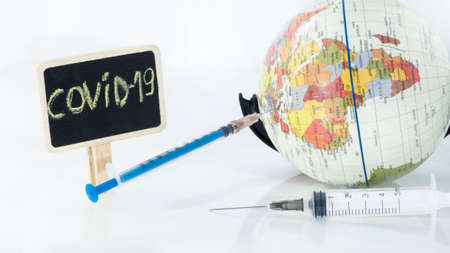5th EU-JAV Newsletter September 2021
Welcome to the fifth JAV newsletter!
‘Dear Partner,
Welcome to our latest newsletter, the fifth of the project; as for the previous ones, we want to inform you on what kept us busy, and to provide information on EU-JAV advances.
As you may know by now, the EU-JAV project is being extended for 8 months, until the end of March 2022. These incoming months will be the opportunity to produce much more results in the vaccination field.
Have a good week and enjoy your reading!’
Introduction by Olivier Epaulard, Coordinator of the Joint Action, INSERM

Dear all,
While an unprecedented vaccine campaign is underway on all continents, the future of the Covid-19 pandemic is still uncertain, and we face many questions: How may we obtain a high global vaccine coverage (and not only in some privileged area)? Do we need to vaccinate children under the age of 12? Do we need to perform a booster, third vaccine dose in those most à risk? Is it relevant to mandate vaccination for healthcare workers, or to other categories? How necessary is it to generalize the use of a vaccine pass? How may we address the vaccine hesitancy of many, and the opposition to vaccination of small but noisy groups? Which priorities should we set regarding research in vaccines? May the different national recommendations be even more convergent? Is there room for improvement in the way the different countries acquire vaccines (even if in this case, vaccine procurement was a central process)?
The works the EU-JAV has recently made public may help those in charge regarding some of these questions; as you will find below, the following new deliverables have indeed been issued, including:
- A pilot survey to explore and compare the decision-making process of different National immunisation technical advisory groups (NITAGs)
- A report on the standardisation of this assessment of vaccine coverage;
- A report on financial mechanisms for vaccine procurement;
- The second Annual List on Research Priorities on Vaccination;
- A detailed analysis of the activities in EU, which addressed vaccine hesitancy and uptake, including best practices and lessons learned.
Those different documents may not have been elaborated focusing on Covid-19; however, as the previous EU-JAV works, the analyses they provide shed a useful light of the current situation of Covid-19 vaccination – in addition to their important contribution regarding other vaccines.
As you may be aware, the EU-JAV is launching its first InfoDay on the 15th of October (see below). We hope this online meeting will be an opportunity to communicate of a broad audience the works of the EU-JAV since it was opened 3 years ago. We will be very glad to have you at this particular occasion!
Yours,
O.Epaulard
EU-JAV coordinator
Covid-19 Vaccines: many answers, many questions, and enduring hope

The Covid-19 pandemic has cast a new light on many issues regarding the control of a transmissible infection. How much of an airborne disease is due to aerosolization? Which level of distancing is needed to prevent the propagation of an infection before vaccines are available? What is the most efficient way to perform large-scale diagnosis: mass centres, self-testing, family-doctor-based? To what extent the governments need to document the identity and contacts of those infected? How protective is post-infection immunity? Do you need to detect any infection, or just symptomatic cases, or just severe cases? The last 20 months have illustrated how crucial these different questions may be, and how the answers may evolve along time; we have changed our views on Covid-19, but also on many other infections.
Maybe one of the most striking facts is how open data have completely modified the perception we may have of a public health event. Indeed, many governments and agencies are providing in open access many different field data regarding the pandemic; this allows not only scientists and health professionals to have a direct, immediate insight on the number of cases and the impact of measures, but also virtually any citizen with an internet access to have a look on what is ongoing, and even – for the most skilled – to contribute to the visualization and the understanding of these data.
After they were proven efficient and therefore were used in mass campaigns, the anti-SARS-CoV-2 vaccines have generated both the same level of data and the same level of questions. Being the main hope to exit the pandemic, they have focused the world attention as never seen before. Since the first doses were injected in December 2020 (apart from the clinical trials), and after more than 1 billion of doses the vaccines approved by the EMA have been injected, many questions marks have found an answer, while others came to in front of the stage. The safety of these vaccines is extremely high in adults, but this might be different at younger age; the neutralization potency of vaccine-triggered antibodies is remarkable for the initial Wuhan viral strain, but it is lower for some variants, particularly delta; a decay of the antibody titre is reported, but the need of a third, boosting dose is not perceived uniformly by health authorities; the correlates of protection are still to be defined, but serology may find a role in some populations; those with a past infection may not need more than one dose of vaccine, but this is also not appreciated uniformly across different countries; the emergence of new variants escaping the vaccine-induced immunity may occur in the near future, but the impact on the risk of severe forms cannot be easily predicted; and, maybe more important than any other aspects, the fact that many countries had not yet the opportunity to perform mass vaccination is a major threat for their populations, and for the sustainable control of the pandemic at a global level.
In addition, the efforts toward the highest vaccine coverage still face the opposition of few, and the hesitation of many. Even if the proportion of vaccinated is higher than the intentions expressed in last winter in Europe, the adhesion to the Covid-19 vaccines is still not uniform across our societies.
We may have reached a tipping point toward the control of the pandemic: it is our collective responsibility to ensure that all have access both to vaccine doses and to information.
What have we done so far?

A number of new steps were taken within the EU-JAV project during these last few months:
1. Extension of the project
Considering the pandemic situation in which all we are all today, the partners of the project have decided earlier in 2021 to ask for an extension of 8 months to the European Commission. This extension has been granted this summer and will allow us to integrate the Covid-19 research, recommendations and questions to be added in our work. It will benefit all to have access to such data and to disseminate it overall. The official end of the project is now due on March 31st 2022.
2. Deliverables
Since it began, the EU-JAV have continuously publicised its work in the form of deliverables. Several deliverables were submitted by the partners during these last months, which are the prime results of our project. You will find below the list of them.
Last Deliverables Approved
Deliverable D2.2
Stakeholder Mapping
The following deliverable is part of Work package 2 – task 2.2 of EU-JAV which aims at informing all project work-packages, particularly concerning their outreaching activities and actions, such as communication activities for project promotion or research. It was made by Hellenic Center for Disease Control and Prevention (HCDCP).
Deliverable 4.6
Methodology and plan for pilot study, and draft plan for extended study, regarding the decision-making process of national immunisation technical advisory groups (NITAGs)
The following deliverable is part of Work package 4 – task 4.3.2.1 of EU-JAV which aims at characterizing the decision-making process of different NITAGs countries regarding the inclusion of vaccines in their national immunization schedules. It was made by FMS.
Deliverable D6.3
Report on financial mechanisms for vaccine procurement, based on a survey among EU/EEA and EU-JAV consortium Member States
The following deliverable is part of Work package 6 – task 6.1.3 of EU-JAV which refers to the objective: Analyze and evaluate local financing mechanisms for purchase and stock of vaccines. It was made by ISS.
Deliverable D8.1
Vaccine hesitancy and uptake. From research and practices to implementation
This report presents the results of the work done in the EU Joint Action on Vaccination (EU-JAV) Work Package 8 (WP8) task 8.1. The aim of task 8.1 is to develop a systematic overview and analysis of the current situation of activities related to vaccine hesitancy and uptake, including best practices and lessons learned in the Member States and their regions. This report has been written by the EU-JAV team at the Finnish Institute for Health and Welfare (THL) leading this work in the EU-JAV.
Deliverable D2.4
Strategic Dissemination Plan
The following deliverable is part of Work package 2 – task 2.4 of EU-JAV which sets out a strategy for the dissemination of information stemming from the EU-JAV (European Joint Action on Vaccination) activities and results. It outlines a plan to connect the relevant target audiences with EU-JAV by means of appropriate communication tools. It was made by HCDCP and EODY/NPHO.
Deliverable 5.3
Report on standardized estimations of vaccine coverage
The following deliverable is part of Work package 5 – task 5.3 (WP5.2) of EU-JAV which aims to establish common methodological guidelines, data structure and criteria for standardized assessment of vaccination coverage. It was made by Statens Serum Institut (SSI).
Deliverable 7.2
Second Annual List on Research Priorities on Vaccination
The following deliverable is part of Work package 7 – task 7.2 of EU-JAV which refers to the outcome of the final face-to-face meeting of experts, which allowed the articulation of a second list of research priorities on vaccination. It was made by Inserm.
Next Event

Save the date!
15 October 2021 The EU-JAV Info Day
Strengthening European Cooperation to fight vaccine-preventable diseases
EU JAV is the EU Joint Action on Vaccination, co-funded by the Health programme of the European Union, and run by a consortium of 20 partners across Europe, aiming at:
exploring the possibilities toward harmonized vaccine procurement /policies in EU/EEA
improving forecasting of vaccine stocks and systems for the prevention of shortages
setting priorities for research and development on vaccination
understanding and addressing at a European level how to enhance public confidence in vaccination
During this day, the audience will have the opportunity to have an overview of all EU-JAV actions since it was launched in 2018, and a presentation of the work it achieved in different domains regarding vaccination. Attendance of the EU-JAV Info Day virtual event will be completely free. Registrations will open soon! More information will be circulated in due time and will be published on the EU-JAV website.
Stay tuned! Please, share the EU-JAV Save-the-Date notice with any person / consortium interested.
Coordinator: INSERM Info Day organisers: NPHO, INSERM Contact: Prof. Olivier Epaulard, Laure Vidal, Stelios Lefkovits
